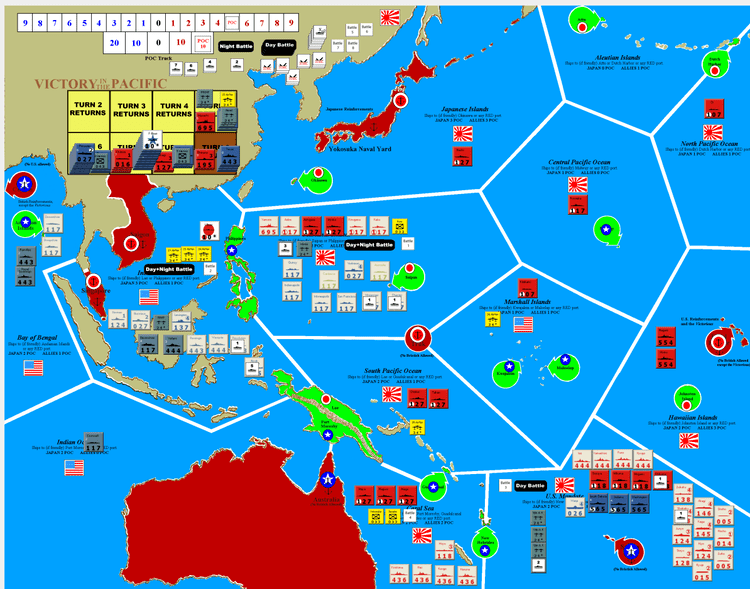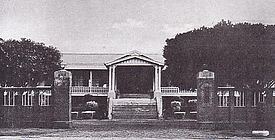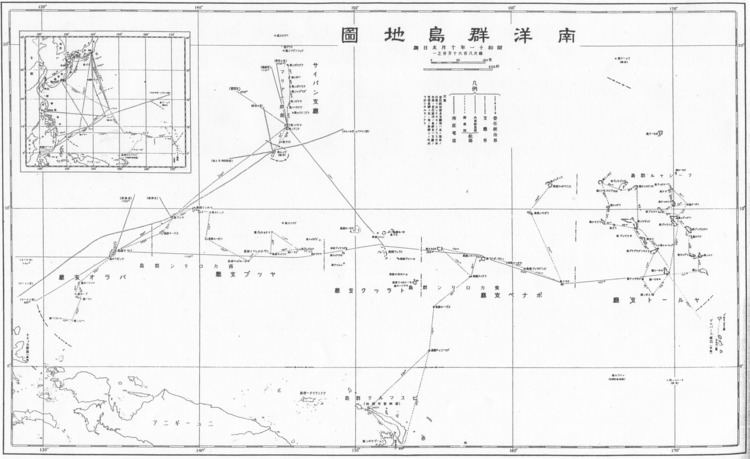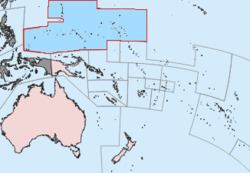Capital Koror 1926–1947 Shōwa (Hirohito) Founded 1919 | 1919–1926 Taishō (Yoshihito) 1919–1923 (first) Toshirō Tezuka Date dissolved 1947 | |
 | ||
Languages Japanese (official)
Austronesian languages Political structure Mandate of the Empire of Japan Currencies Japanese yen, Japanese government-issued Oceanian Pound | ||
The South Pacific Mandate was a League of Nations mandate given to the Empire of Japan by the League of nations following World War I. The South Pacific Mandate consisted of islands in the north Pacific Ocean that had been part of German New Guinea within the German colonial empire until they were occupied by Japan during World War I. Japan governed the islands under the mandate until World War II when the United States captured the islands. The islands then became the United Nations-established Trust Territory of the Pacific Islands governed by the United States. The islands are now part of Palau, Northern Mariana Islands, Federated States of Micronesia, and Marshall Islands.
Contents
In Japan, the territory is known as "Japanese mandate for the South Seas Islands" (日本委任統治領南洋群島, Nihon Inin Tōchi-ryō Nan'yō Guntō) and was governed by the Nan'yō Government (南洋庁, Nan'yō Chō).

Origin

The Anglo-Japanese Alliance of 1902 had been signed primarily to serve Britain's and Japan's common interest of opposing Russian expansion. Amongst other provisions the treaty called on each party to support the other in a war against more than one power, although it did not require a signatory state to go to war to aid the other. Within hours of Britain's declaration of war on Germany in 1914, Japan invoked the treaty and offered to declare war on the German Empire if it could take German territories in China and the South Pacific. The British government officially asked Japan for assistance in destroying the raiders from the Imperial German Navy in and around Chinese waters, and Japan sent Germany an ultimatum demanding that it vacate China and the Marshall, Mariana and Caroline islands. The ultimatum went unanswered and Japan formally declared war on Germany on 23 August 1914.

Japan participated in a joint operation with British forces in autumn 1914 in the Siege of Tsingtao (Qingdao) to capture the Kiautschou Bay concession in China's Shandong Province. The Imperial Japanese Navy was tasked with pursuing and destroying the German East Asiatic Squadron and protection of the shipping lanes for Allied commerce in the Pacific and Indian Oceans. During the course of this operation, the Imperial Japanese Navy seized the German possessions in the Marianas, Carolines, Marshall Islands and Palau groups by October 1914.

After the end of World War I, the protectorate of German New Guinea was divided amongst the war's victors by the Treaty of Versailles. The southern part of the protectorate was mandated to come under Australian administration as the Territory of New Guinea, consisting of Kaiser-Wilhelmsland (the German territory on the island of New Guinea) and the German-controlled islands south of the equator. Meanwhile Japanese occupation of the northern part of the protectorate, consisting of the Micronesian islands north of the equator, was formally recognised by the treaty. Japan was given a League of Nations Class C mandate to govern them, the terms of which specified that the islands should be demilitarised and Japan should not extend its influence further into the Pacific. The Mandate was initially subject to yearly scrutiny by the Permanent Mandates Commission of the League of Nations in Geneva, though by the late 1920s Tokyo was rejecting requests for official visitation or international inspection.

The government of the South Pacific Mandate built and maintained hospitals and schools. Compulsory schooling was used to promote Japanese state religion and Shinto rituals. A Shinto shrine known as the Nanyo Shrine was built on Koror.
Administration
Following the initial Japanese occupation of the islands, a policy of secrecy was adopted. Japan made it plain that it did not welcome the entry of foreign ships into Micronesian waters, even those of its wartime allies. During the first five years that Japan occupied the islands, it consolidated its presence and the islands became a virtual Japanese colony. The Imperial Japanese Navy divided the territory into five naval districts in Palau, Saipan, Truk, Ponape, and Jaluit Atoll, all reporting to a rear admiral at the naval headquarters at Truk.
A proposal at the Versailles Conference to allow trade and migration between those islands to be administered by Japan and those to be administered by Australia and New Zealand was rejected. Japan was able to continue administering the islands as if they were colonial possessions, keeping their waters off limits to foreigners. When the islands became legally a League of Nations Mandate, Japan administered them as Japanese territory and as part of the Japanese Empire. This situation continued even after Japan withdrew from the League of Nations in 1935 and lost its legal claim to administer the islands.
Militarily and economically, Saipan, in the Marianas archipelago, was the most important island in the South Pacific Mandate and became the center of subsequent Japanese settlement. The towns of Garapan (on Saipan), Koror (on Palau) and Colony (on Ponape) were developed to resemble small towns in Japan, with cinemas, restaurants, beauty parlours and geisha houses. Another important island was Truk in the Carolines archipelago, which was fortified into a major navy base by the Imperial Japanese Navy.
Between 1914 and 1920 the islands began the slow transition from naval to civilian administration. By 1920 all authority had been transferred from the Naval Defense Force to the Civil Affairs Bureau which was directly responsible to the Navy Ministry. Initially based in Truk, the Civil Affairs Bureau was moved to Koror in the Palau islands in 1921. The naval garrisons were disbanded to comply with the terms of the Mandate. In April 1922 a civilian government was established in each of the six administrative districts (Saipan, Palau, Yap, Truk, Ponape and Jaluit) in the form of a civil administration department which still reported to the local naval garrison commander. At the same time a post of Governor of the South Pacific Mandate was created. Governors were mostly admirals or vice-admirals as the administration was initially still the responsibility of the Imperial Japanese Navy. The Governor reported directly to the Prime Minister of Japan. After the establishment of the Ministry of Colonial Affairs in June 1929, the Governor reported to the Minister of Colonial Affairs instead. The establishment of the "South Seas Government" or "Nan'yo-Cho" in March 1932 finally put the government of the islands under a purely civilian administration. When the Ministry of Colonial Affairs was absorbed into the Ministry of Greater East Asia in November 1942, the primacy of the Imperial Japanese Navy was again recognized by the appointment of an admiral as the Governor. Furthermore, the six administrative districts were reduced to three in November 1943: North, East, and West.
Significance
The population of the South Pacific Mandate was too small to provide significant markets and the indigenous people had very limited financial resources for the purchase of imported goods. The major significance of the territory to the Empire of Japan was its strategic location, which dominated sea lanes across the Pacific Ocean and provided convenient provisioning locations for sailing vessels in need of water, fresh fruit, vegetables and meat. The territory also provided important coaling stations for steam-powered vessels.
Population
The population of the islands increased during the period of the mandate as a result of Japanese settlement in Micronesia. Settlers were initially drawn from Okinawa Island and the other Ryukyu Islands, but immigrants subsequently came from other parts of Japan, particularly the economically-deprived Tōhoku region. Agricultural workers were followed by shopkeepers, restaurant, geisha house and brothel-keepers, expanding former German settlements into Japanese boom towns. The initial population figures (1919-1920) for the mandated territories included around 50,000 islanders, made up from the indigenous peoples of Oceania. Japanese immigration led to the population growing to 70,000 inhabitants in 1930, and more than 80,000 in 1933. By 1935 the Japanese population alone was more than 50,000. In the census of December 1939, the total population was 129,104, of which 77,257 were Japanese (including ethnic Taiwanese and Koreans), 51,723 indigenous islanders and 124 foreigners. The rights and status of the indigenous Micronesian population differed from those of Japanese imperial subjects. Micronesian children's schooling took place in separate schools and was more limited. Similarly employment prospects for Micronesians was more restricted, with unequal labor conditions and pay.
Economy
Before the establishment of the South Pacific Mandate, small groups of Japanese entrepreneurs established commercial ventures in German Micronesia and came to control a significant proportion of the trade. However, the economic development of the area was hampered by the distances separating the islands, their small land areas and their small market sizes. The mandate was initially a financial liability for the Japanese government, requiring an annual subsidy from Tokyo. During the 1920s and 1930s the Japanese government pursued a policy of encouraging monopolies that paired private initiative with government capital. This strategy was intended to maximise the number of Japanese colonists.
Until the late 1930s, the development of the islands was undertaken primarily to assist the Japanese civilian economy. The Japanese entrepreneur Haruji Matsue significantly expanded the quantities of sugar cane produced in the islands, with over 3,000 hectares (7,400 acres) under cultivation by 1925. By the early 1930s the sugar-related industries accounted for more than 60% of the mandate's revenues. Bananas, pineapples, taro, coconuts, manioc, coffee and other tropical farming products were also grown, putting the islands on a par with Taiwan. The islands also provided bases for the Japanese fishing fleet which was centred at Koror. By the end of the 1920s the mandate became self sufficient, no longer needing subsidy and financially contributing to the Japanese Empire.
The Japanese took over German phosphate mines on Angaur island and expanded them. Smaller phosphate mines on neighbouring islands were also opened. Total exports to Japan eventually reached around 200,000 tonnes per year. Angaur island alone produced some 60,000 tonnes per year. The phosphates were used for farming. Another mineral product was Bauxite which was another segment of the colonial economic structure, although the mineral was only present in the Palau group. Large quantities of pearls, both natural and cultured, were extracted from the islands.
The South Seas Trading Company had an exclusive contract from 1915 with the Japanese Navy to provide freight, passenger, and mail services to the Empire as well as between the islands. The route between the Empire and the islands was subsequently taken over by the Japanese Mail Steamship Company (Nippon Yusen Kaisha), the largest steamship line in the Empire. The luxurious amenities offered on board some of the company's vessels brought about the beginning of Japanese tourism to the islands.
The flying boat was the principal type of aircraft used for commercial aviation due to the shortage of flat land available for airfields. Imperial Japanese Airways began some commercial flights in 1935 using the long-range Kawanishi H6K2-L seaplane (known to the Allies of World War II as "Mavis"). Regular commercial flights were begun in 1940 and a regular service commenced in 1941. Commercial services ceased shortly after the start of Pacific War, but the widespread network of seaplane bases continued to be used during wartime.
Pacific War
During the 1930s, the Imperial Japanese Navy began construction of airfields, fortifications, ports, and other military projects in the islands controlled under the mandate, viewing the islands as "unsinkable aircraft carriers" with a critical role to play in the defense of the Japanese home islands against potential US invasion. These became important staging grounds for Japanese air and naval offensives in the Pacific War.
The Imperial Japanese Army also utilized the islands to support air and land detachments.
In order to capture the islands from Japan, the United States military employed an "island-hopping" strategy which involved conducting amphibious assaults on selected Japanese island fortresses, subjecting some to air attack only and entirely skipping over others. This strategy caused the Japanese Empire to lose control of its Pacific possessions between 1943 and 1945.
The League of Nations mandate was formally revoked by the United Nations on July 18, 1947 pursuant to Security Council Resolution 21, making the United States responsible for administration of the islands under the terms of a United Nations trusteeship agreement which established the Trust Territory of the Pacific Islands.
